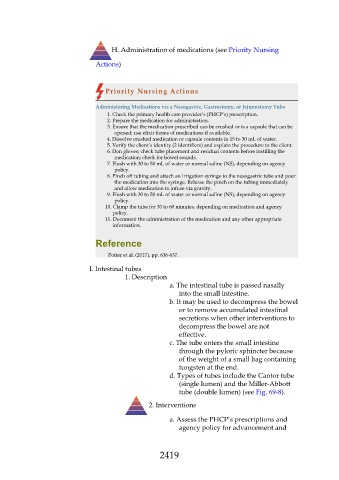Page 2419 - Saunders Comprehensive Review For NCLEX-RN
P. 2419
H. Administration of medications (see Priority Nursing
Actions)
Priority Nursing Actions
Administering Medications via a Nasogastric, Gastrostomy, or Jejunostomy Tube
1. Check the primary health care provider’s (PHCP’s) prescription.
2. Prepare the medication for administration.
3. Ensure that the medication prescribed can be crushed or is a capsule that can be
opened; use elixir forms of medications if available.
4. Dissolve crushed medication or capsule contents in 15 to 30 mL of water.
5. Verify the client’s identity (2 identifiers) and explain the procedure to the client.
6. Don gloves; check tube placement and residual contents before instilling the
medication; check for bowel sounds.
7. Flush with 30 to 50 mL of water or normal saline (NS), depending on agency
policy.
8. Pinch off tubing and attach an irrigation syringe to the nasogastric tube and pour
the medication into the syringe. Release the pinch on the tubing immediately
and allow medication to infuse via gravity.
9. Flush with 30 to 50 mL of water or normal saline (NS), depending on agency
policy.
10. Clamp the tube for 30 to 60 minutes, depending on medication and agency
policy.
11. Document the administration of the medication and any other appropriate
information.
Reference
Potter et al. (2017), pp. 636-637.
I. Intestinal tubes
1. Description
a. The intestinal tube is passed nasally
into the small intestine.
b. It may be used to decompress the bowel
or to remove accumulated intestinal
secretions when other interventions to
decompress the bowel are not
effective.
c. The tube enters the small intestine
through the pyloric sphincter because
of the weight of a small bag containing
tungsten at the end.
d. Types of tubes include the Cantor tube
(single lumen) and the Miller-Abbott
tube (double lumen) (see Fig. 69-8).
2. Interventions
a. Assess the PHCP’s prescriptions and
agency policy for advancement and
2419

